
San Francisco forest garden
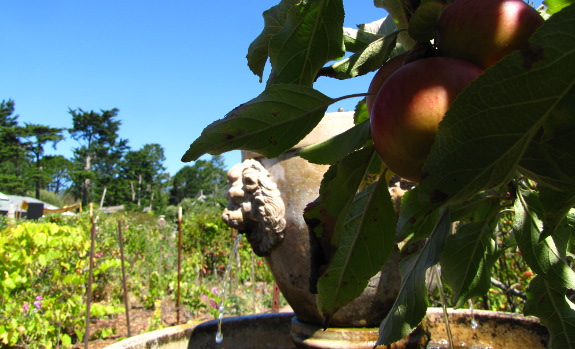
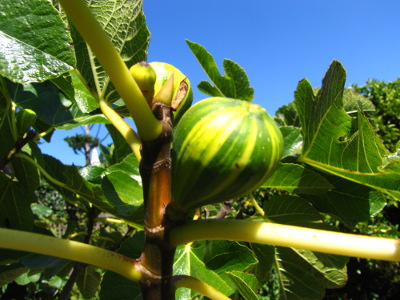
The food at my
brother's wedding
was superb, but I'm afraid I didn't eat much.
You see, I'd filled up
on apples, trying to sample every currently-ripe variety in the father
of the bride's forest garden.
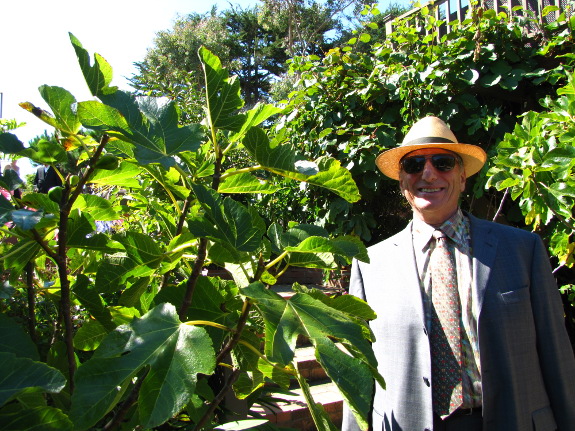
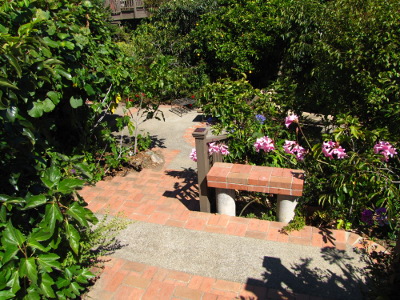 Ira
Steinman has been
forest gardening in the San Francisco Bay area for
forty years, and the result is a masterpiece that will inspire those of
us nurturing our first little trees. I'm afraid I was only able
to grab him out of the crowd for a few quick questions, but in many
ways the garden spoke for itself. Come along and we'll walk
through together!
Ira
Steinman has been
forest gardening in the San Francisco Bay area for
forty years, and the result is a masterpiece that will inspire those of
us nurturing our first little trees. I'm afraid I was only able
to grab him out of the crowd for a few quick questions, but in many
ways the garden spoke for itself. Come along and we'll walk
through together!
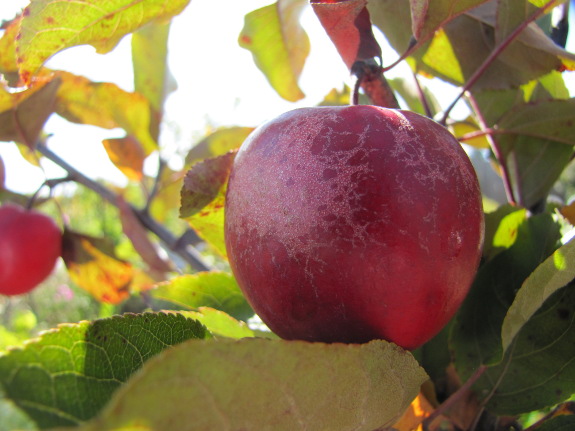
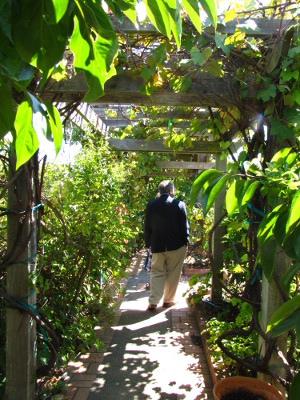
Ira had clearly put a
lot of thought into structural elements --- I could tell because I
barely noticed anything except plants until after I got home and
started flipping through the photos. Instead of jumping out at
you, paths, arbors, and steps drew you down into the garden and enticed
you to explore.
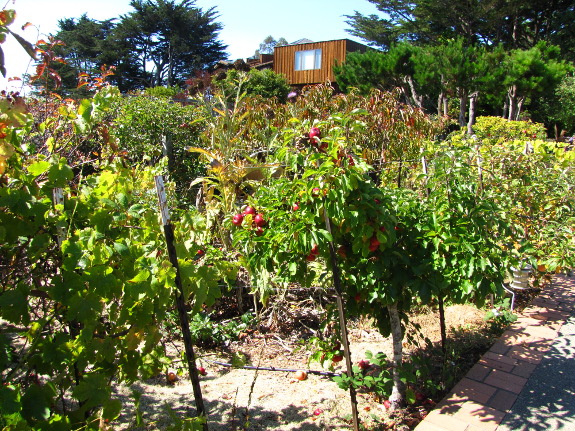
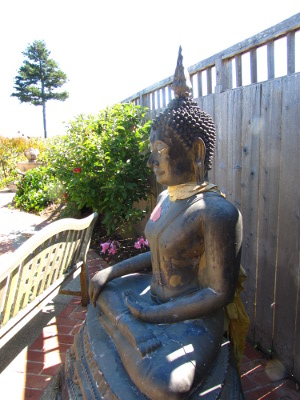 The property boasts a stunning view of the San Francisco
Bay (or perhaps more technically the San
Rafael Bay, but it's all connected). Not wanting to block the view, Ira
planted dwarf apples in the upper part of the garden, then graduated
into what I'm guessing are semi-dwarfs further down the hill.
The property boasts a stunning view of the San Francisco
Bay (or perhaps more technically the San
Rafael Bay, but it's all connected). Not wanting to block the view, Ira
planted dwarf apples in the upper part of the garden, then graduated
into what I'm guessing are semi-dwarfs further down the hill.
The garden location that
permaculturalists would call zone 1, right outside the house, was a
more formal area with benches, a lawn for gatherings (and marrying off
their kids), and huge buddhas brought home from Asia to inspire
conversation. Just as tree size increased as you ventured further
from the house, so did the garden become less formal and more wild.
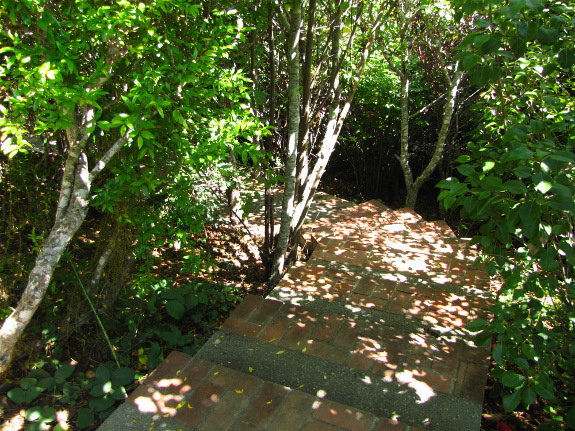
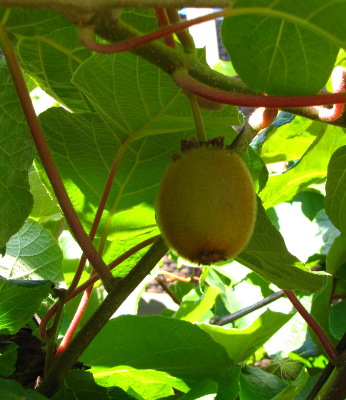 I liked the fact that Ira
stuck to brick pathways throughout, even in the less formal
areas. Despite being located in zone 8 in a microclimate that
hasn't seen a killing frost for 22 years, the Bay area garden still has
to contend with cool summer temperatures that can make ripening summer
fruits a challenge. I suspect that capturing heat with these
stone pathways helps the summer garden, even though Ira reports his
citrus still tend to be on the sour side. (Most citrus fruit need
summer heat to pack away sugars, which is why dwarf
Meyer lemons are
likely to give those of us growing citrus indoors better results than
most other choices will.)
I liked the fact that Ira
stuck to brick pathways throughout, even in the less formal
areas. Despite being located in zone 8 in a microclimate that
hasn't seen a killing frost for 22 years, the Bay area garden still has
to contend with cool summer temperatures that can make ripening summer
fruits a challenge. I suspect that capturing heat with these
stone pathways helps the summer garden, even though Ira reports his
citrus still tend to be on the sour side. (Most citrus fruit need
summer heat to pack away sugars, which is why dwarf
Meyer lemons are
likely to give those of us growing citrus indoors better results than
most other choices will.)
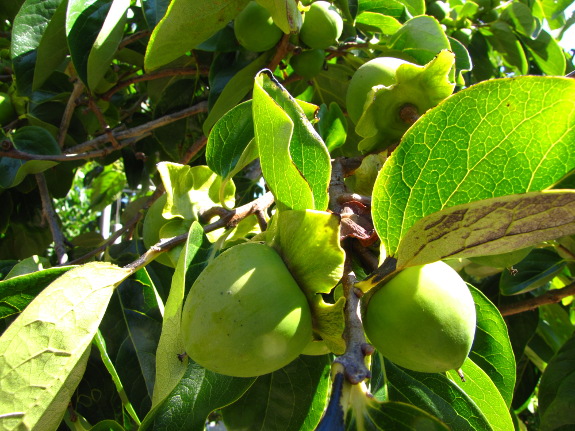
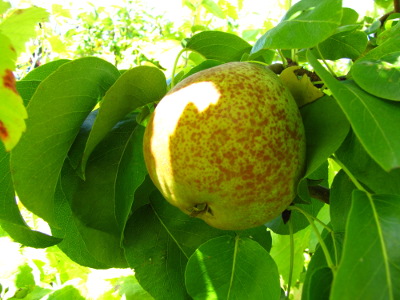 So
what's growing in this stunning forest garden? The apples are
what captured my eye and what seemed to be doing the best, perhaps
because Ira had chosen most of them from a nearby heirloom apple
nurseriest who knew just what would thrive north of San
Francisco. But there were also lots of Asian persimmons, pears,
and figs sporting unripe but luscious-looking fruit.
So
what's growing in this stunning forest garden? The apples are
what captured my eye and what seemed to be doing the best, perhaps
because Ira had chosen most of them from a nearby heirloom apple
nurseriest who knew just what would thrive north of San
Francisco. But there were also lots of Asian persimmons, pears,
and figs sporting unripe but luscious-looking fruit.
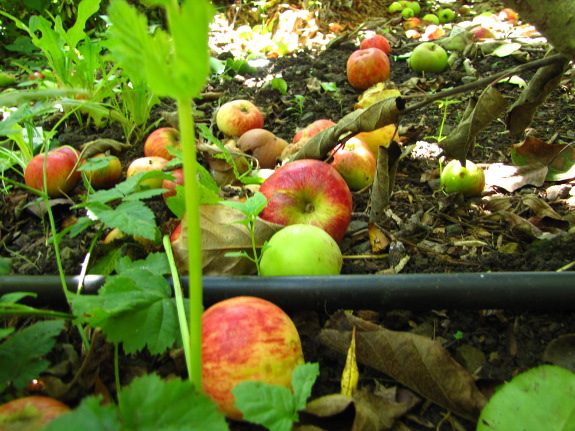
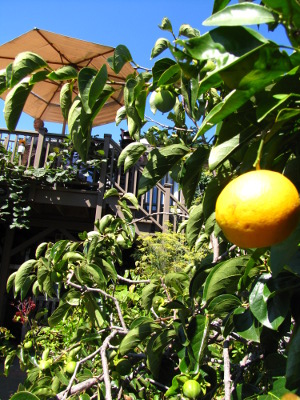 Ira's
garden was also dotted with ripening citrus orbs. I couldn't
identify them all, but Ira pointed out an Algerian mandarin
as he passed by doing his hostly duties, and a friend of the family
shared a pomelo, which was a bit like a grapefruit.
Ira's
garden was also dotted with ripening citrus orbs. I couldn't
identify them all, but Ira pointed out an Algerian mandarin
as he passed by doing his hostly duties, and a friend of the family
shared a pomelo, which was a bit like a grapefruit.
The sheer quantity of
fruit being produced by this 1.5 acre garden was astonishing. I
could tell from the apples littering the ground that the bounty was
more than Ira could handle, and I fed lots of guests hand-plucked fruit
without seeming to make a dent in the wares on display. In fact,
my stepmother stuck a few fruits in her purse to snack on later, and I
suspect she wasn't the only one.
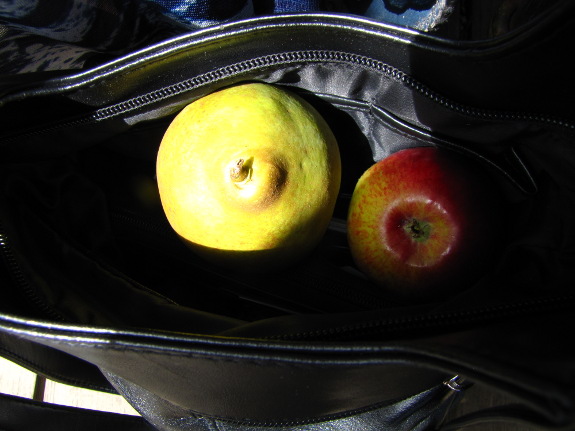
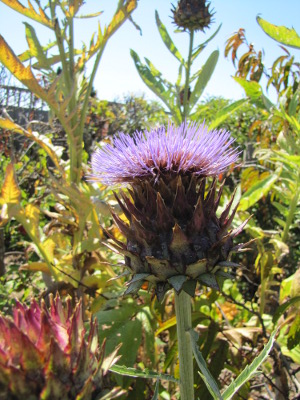 One of the things I liked the
most about Ira's forest garden is that the trees were clearly
king. I think that many of us who read the forest
gardening literature come into our gardens thinking that we can
fill all five levels with delicious edible trees, shrubs, and herbs
that won't compete at all. But Ira didn't read any of those books
(perhaps because they didn't exist when he got started), so he focused
on trees in most of his garden, separating herbs like this Roman
artichoke out into sunny clearings. Knowing your priority
in each part of a garden helps you mix and match secondary plantings
without lowering yields from the plants you care about the most.
One of the things I liked the
most about Ira's forest garden is that the trees were clearly
king. I think that many of us who read the forest
gardening literature come into our gardens thinking that we can
fill all five levels with delicious edible trees, shrubs, and herbs
that won't compete at all. But Ira didn't read any of those books
(perhaps because they didn't exist when he got started), so he focused
on trees in most of his garden, separating herbs like this Roman
artichoke out into sunny clearings. Knowing your priority
in each part of a garden helps you mix and match secondary plantings
without lowering yields from the plants you care about the most.
Despite focusing on the
trees, Ira's landscape still felt like a forest garden, not like an
orchard. Trees were planted close enough together than they
produced a nearly closed canopy, and grapes, kiwis, ornamentals, and
shrubbier plants like figs were interspersed. (Guests who had
been to the garden before it was manicured for the 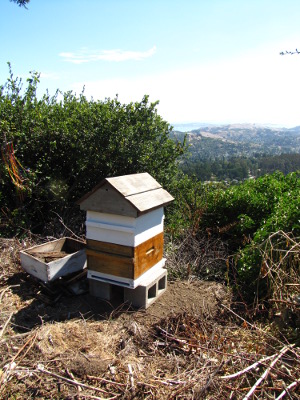 wedding also told me that our
ability to stroll down the paths is a new affair --- I suspect the
garden had more of a jungle feel previously.)
wedding also told me that our
ability to stroll down the paths is a new affair --- I suspect the
garden had more of a jungle feel previously.)
I left the garden with
more questions than answers. What did the early stages of the
garden look like? Did Ira have to amend the soil heavily?
Does he water his trees with drip irrigation? How long did it
take before the forest garden began overflowing with bounty? Did
he face special challenges due to his location? Are there species
and varieties he particularly recommends for the Bay area?
The specifics aside,
though, the garden itself told me everything I needed to know.
Forty years later, a forest garden does look like a forest while being
as productive as a garden. The idea has merit --- let's plant
some more trees!
Want more in-depth information? Browse through our books.
Or explore more posts by date or by subject.
About us: Anna Hess and Mark Hamilton spent over a decade living self-sufficiently in the mountains of Virginia before moving north to start over from scratch in the foothills of Ohio. They've experimented with permaculture, no-till gardening, trailersteading, home-based microbusinesses and much more, writing about their adventures in both blogs and books.
Want to be notified when new comments are posted on this page? Click on the RSS button after you add a comment to subscribe to the comment feed, or simply check the box beside "email replies to me" while writing your comment.

I got this additional information just this morning from Ira:
"It took three to five years for most of the apples to start to fruit; the lower--and some of the upper--apples are standard, but heavily pruned.
"There is drip irrigation everywhere, but I tend to wander around with a hose and clippers an hour a week and water each tree and grape in the heat. Mulch is everywhere mounded around everything.
"One thing you might think about is the beauty of planting veggies under fruit trees. Especially in the shadier areas, lettuces grow year round.
"I did amend the soil a lot. Most of the area was covered with 80 very tall cypress which I cut down and allowed to moulder into the soil. I then brought in 10 truckloads of mushroom compost--about 120 tons and gradually threw it into the garden.
"French intensive gardening from the 60s was one of my prime intellectual forebears, as was growing up in the wholesale fruit and produce business.
"The good figs began to provide fruit within six months. Don't forget, there are also about 800 rose bushes and allees from which to observe them.
"Feel free to use any of this material.
"Lovely meeting you Anna. Feel free to contact me with any questions or plumb my gardening acumen as you like."
Definitely aspiring. I have seen in a myriad of places the 'productive live' of various trees and fruiting bushes. After 40 years, I would think that maybe some are reaching past their prime. I wonder if he has any experience with the need to replace or seriously rejuvenate any of this trees. I wonder if the major pruning on the standard apples keeps them 'young and vibrant.' I have read that coppicing hard woods can extend the lives of trees and wonder if the management of the fruit trees has had a similar effect, or if productivity has declined at all.
I also love how the design starts more structured near the living areas and gets more informal further into the garden.
Mona --- I'm not sure standard apples would be past their prime in 40 years. These guys definitely didn't look unhappy.... Things like peaches probably would be long gone, but Ira reported he didn't have luck with them in his climate anyway.
Interesting idea about the heavy pruning rejuvenating fruit trees....
Jen g --- I guess a more extroverted person would plan a book signing or something while on the road to take advantage of being a celebrity. (Ha! I had to laugh at you calling us that. )
)
It was definitely beautiful country out your way. Sorry we missed you!